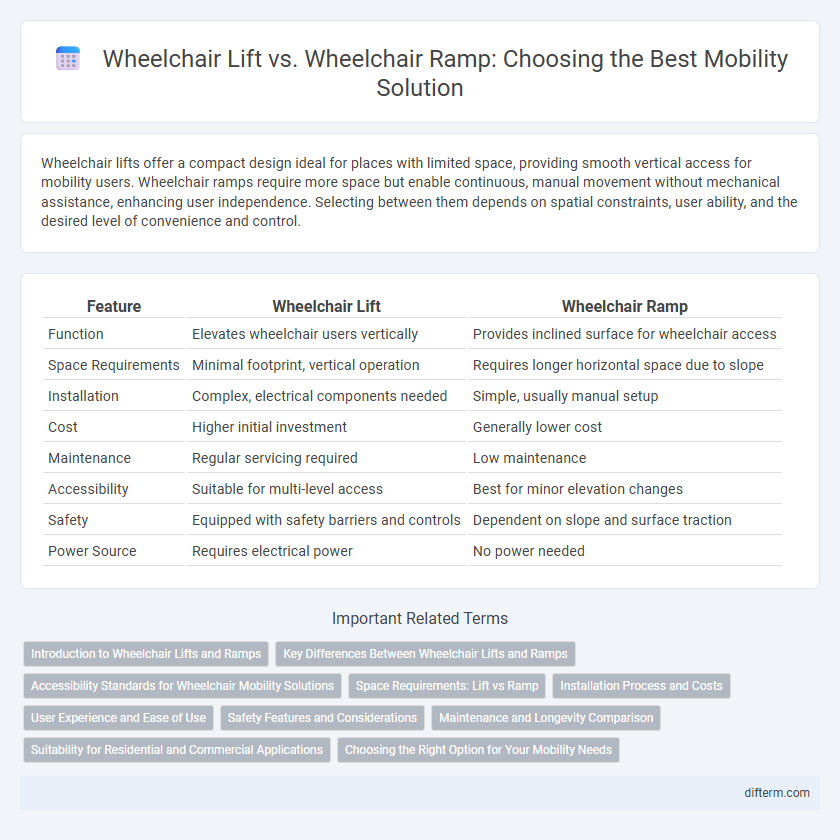Wheelchair lifts offer a compact design ideal for places with limited space, providing smooth vertical access for mobility users. Wheelchair ramps require more space but enable continuous, manual movement without mechanical assistance, enhancing user independence. Selecting between them depends on spatial constraints, user ability, and the desired level of convenience and control.
Table of Comparison
| Feature | Wheelchair Lift | Wheelchair Ramp |
|---|---|---|
| Function | Elevates wheelchair users vertically | Provides inclined surface for wheelchair access |
| Space Requirements | Minimal footprint, vertical operation | Requires longer horizontal space due to slope |
| Installation | Complex, electrical components needed | Simple, usually manual setup |
| Cost | Higher initial investment | Generally lower cost |
| Maintenance | Regular servicing required | Low maintenance |
| Accessibility | Suitable for multi-level access | Best for minor elevation changes |
| Safety | Equipped with safety barriers and controls | Dependent on slope and surface traction |
| Power Source | Requires electrical power | No power needed |
Introduction to Wheelchair Lifts and Ramps
Wheelchair lifts provide mechanical assistance to elevate individuals, enabling access to elevated surfaces where ramps may be impractical due to space constraints or steep gradients. Ramps offer a cost-effective, low-maintenance solution with a gentle incline, ideal for gradual height differences and independent mobility. Understanding the specific spatial and user needs determines the optimal choice between wheelchair lifts and ramps for mobility accessibility.
Key Differences Between Wheelchair Lifts and Ramps
Wheelchair lifts provide vertical elevation for overcoming stairs, offering accessibility in limited spaces where ramps are impractical. Ramps enable gradual incline transitions, requiring more horizontal space and conforming to ADA slope guidelines for safety and ease of use. While lifts are mechanical and require power, ramps are passive, relying on physical design and materials to ensure durability and stability.
Accessibility Standards for Wheelchair Mobility Solutions
Wheelchair lifts and ramps must comply with ADA guidelines to ensure safe and accessible mobility for wheelchair users; lifts require electrical certifications and regular maintenance, while ramps demand specific slope ratios, handrails, and slip-resistant surfaces. Accessibility standards emphasize precise measurements, such as a maximum 1:12 rise-to-run ratio for ramps and load capacity requirements for lifts, to accommodate diverse mobility needs. Proper adherence to these regulations directly influences the independence and safety of wheelchair users in public and private spaces.
Space Requirements: Lift vs Ramp
Wheelchair lifts require less horizontal space compared to ramps, making them ideal for areas with limited footprint, as they operate vertically to elevate users. Ramps need a considerable length to maintain ADA-compliant slopes, typically a 1:12 ratio, resulting in longer, more space-intensive installations. When space constraints are critical, lifts offer a compact solution, while ramps demand extensive area for safe, gradual inclines.
Installation Process and Costs
Wheelchair ramps generally have a simpler installation process, often requiring basic construction tools and can be self-installed or done by a contractor, with costs ranging from $1,200 to $5,000 depending on materials and length. Wheelchair lifts involve more complex installation by certified technicians, including electrical work and compliance with safety codes, leading to higher costs typically between $5,000 and $15,000. Maintenance expenses for lifts are also higher due to mechanical parts, making ramps a more budget-friendly option for long-term use.
User Experience and Ease of Use
Wheelchair lifts offer enhanced user experience by providing effortless access with minimal physical exertion, making them ideal for environments with limited space or steep elevations. Wheelchair ramps require manual navigation that can be challenging for users with limited strength or mobility, affecting ease of use, especially over long distances or steep inclines. Incorporating automated control panels and safety features, wheelchair lifts prioritize convenience and security, while ramps depend on the user's capability and external assistance for safe operation.
Safety Features and Considerations
Wheelchair lifts offer advanced safety features such as automatic barriers, non-slip platforms, and emergency stop controls, reducing the risk of accidents during vertical transport. In contrast, wheelchair ramps rely on gentle slopes with handrails and non-slip surfaces to ensure safe manual navigation, prioritizing simplicity and reliability. Evaluating the user's mobility level, space availability, and potential hazards is crucial in selecting the safest option between a lift or ramp.
Maintenance and Longevity Comparison
Wheelchair lifts require regular mechanical inspections and lubrication to maintain functionality, whereas wheelchair ramps mainly need routine cleaning and surface repairs to prevent wear. The longevity of wheelchair ramps often surpasses that of lifts due to fewer moving parts and lower susceptibility to mechanical failure. Proper maintenance of both options can significantly extend their service life, but ramps generally offer more durable, cost-effective long-term solutions.
Suitability for Residential and Commercial Applications
Wheelchair lifts offer excellent suitability for commercial applications due to their compact footprint and ability to navigate vertical height differences quickly, making them ideal for limited space and compliance with ADA standards. Wheelchair ramps are more common in residential settings, providing a cost-effective, low-maintenance solution that accommodates gradual inclines and easy installation but requires sufficient outdoor or indoor space. Both solutions enhance accessibility, with wheelchair lifts favored for multistory buildings and ramps preferred for single-level entries or gentle elevation changes.
Choosing the Right Option for Your Mobility Needs
Selecting between a wheelchair lift and a wheelchair ramp depends on factors such as available space, budget, and frequency of use. Wheelchair lifts offer vertical movement in compact areas and are ideal for multi-level access, while ramps provide continuous, low-maintenance slopes suitable for gradual elevation changes. Evaluating mobility requirements and structural constraints ensures the best choice for safety and convenience.
wheelchair lift vs wheelchair ramp Infographic

 difterm.com
difterm.com